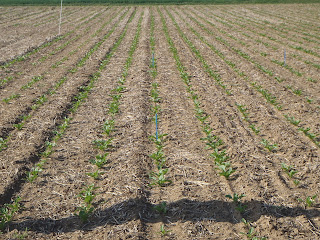Some of the margins have been flouristicly enhanced (wild flowers added to already established grass margins). The margins were topped, then lightly disced. The seed is very expensive and like a bag of tea leaves, it seemed to risky to use a normal drill. I drove the van whilst George sat on the tailgate and sprinkled seed out of the back. They were then pressed and rolled the results are yet to be seen but I have found some trefoil growing. The mix used was sainfoin, trafoil, black medick, red clover, knopweed, ox eye daisy, yarrow, red campion.
 |
| Pollen & Nectar mix after 18 months |
We have now planted 5ha of pollen and nectar in 4 areas. 1ha was planted in 2010 and are now doing very well, I would like to thank Syngenta for there support with this. We have planted 4 mixtures of fine grasses and wild flowers. With the dry spring early growth was slow but when it rained, mid June everything came to life. 1/3 was topped mid July, 1/3 mid August and 1/3 untopped this helped prolong the flowering period however the August cut did not really flower again so probably too late or maybe we will observe differences next spring.
 |
| Phacelia in bloom and wheat harvest |
The remainder of the area was sown spring 2011 but nothing happened until it rained. This mix included phacelia the idea being that it would be flowering by June so when we had school visits they could all walk in and smell the smells, hear the sounds and see the sights. However it did not flower until July /August. The seed mix was sainfoin, vetch, red clover, alsike clover, birdsfoot trefoil, lucerne, black knapweed, musk mallow, phacelia, borage.
 |
| No bent knees here |
Our HLS program includes 7ha of wild bird food plots. A mix of fodder radish, quinoa, barley triticale, wheat millet were sown in May but did not really germinate until the rain came on 'Open Farm Sunday' Sunday. Also sunflowers were added because the seed is cheap and it should look good to passers by but more importantly the birds like them. Most plots have done well the one in the picture is 7ft tall and like a jungle mostly quinoa and fodder radish with the cereals very poor. I am now waiting for some cold winter months to see how well it is received by the birds. I have a man from the BTO arranged to visit through the winter to make some assessments on the bird numbers making use of the sites.
 |
| Hopefully plenty of winter food |





